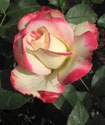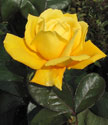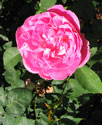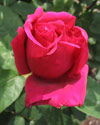(Some) Roses are red...
The rose has thorns only for those who would gather it.- Chinese proverb
 |
 |
 |
|
Cherry Parfait |
Chrysler Imperial |
Sonia |
Oregold |
 |
 |
 |
 |
Radient Perfume |
Pristine |
Whisper |
Peter Mayle |
 |
 |
 |
 |
Jude the Obscure |
Memorial Day |
Bella Roma |
Mary Rose |
Buff Beauty |
Tequila Sunset |
Green Snake |
- Roses like LOTS of water. But, they don't like to stand in water. Dig deep holes when planting roses, and if drainage is a problem in your soil, dig a little deeper to leave a reservoir for water to collect in below the level of the roots. That way you can dump tons of water down past the roots without filling the hole and submerging the roots.
- Roses don't like ANY water on their leaves or flowers. Water on the leaves results in mildew, black spot, and any of half a dozen other maladies. Water on the unopened buds can rot them right out from the inside.Drip irrigation - no spray, no damp soil. Fringe benefits include few weeds. Dry fertilizer becomes a bit of a problem however...
- Roses eat like pigs. They want fertilizer, and they want it now.Use liquid fertilizer, feed the plants via the drip tubes, use dry fertilizer and water occasionally by hand, or feed with a foliage feed during the hottest part of very warm sunny days.
- Aphids graze on roses like pigs in slop. I use a combination of insecticidal soap and sulphur powder to control both aphids and leaf diseases (black spot, mildew, etc). Since this is an application of liquid to the leaves, I try to only apply during warm, sunny periods when the leaves will dry as quickly as possible, even though the sulphur is supposed to mitigate problems. Apply bi-weekly at minimum.
Selecting the perfect Rose -
A little secret I learned from a horticulturist friend of mine is maybe going to help my attitude about roses a bit. His suggestion was to go visit a local grower that does not use any sprays to treat their roses. Pick out a few of your favorites in the spring, then watch those same plants all season. Select only the plants that are disease free in the fall. The bug and leaf disease resistance of each plant is a genetic thing that is shared by all plants of the same variety.
We made three or four trips down to Heirloom Roses last summer, taking hundreds of digital photos, comparing plants based on disease and insect resistance, length of blooming period, shape and size of plant, etc. This winter my wife selected her first David Austin english style roses as a result of this process. The success of this process can be traced here!
Final Comments
Rose bushes range in size from miniatures the size of a soccer ball to enormous brambles that can engulf a house. Blooms range from small five petal single blossoms to densely packed flower heads two feet across. Some varieties bloom once per season, others bloom prolifically all season long. Fragrance can be undetectable to overpowering. Colors range from brightest white to the darkest red, richest gold, most delicate lavendar and every combined shade in-between. Plants can be the most disease-ridden bug infested, blighted, rust encrusted, dry-rotted canes or hundred year old pictures of robust health. It's up to you. Choose wisely.



